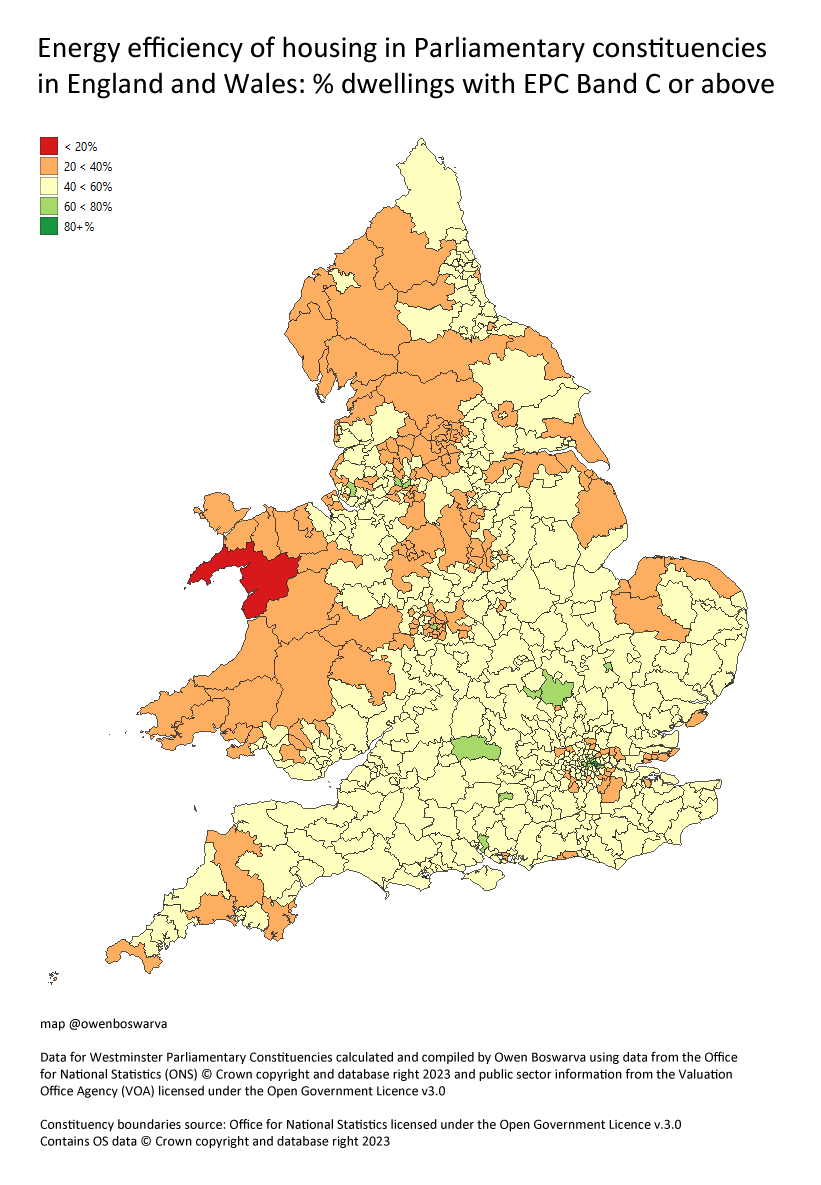This post is a 2023 update to the estimates for energy efficiency of housing in Parliamentary constituencies that I produced last year.
At that time, the UK Government published statistics for the energy efficiency of domestic properties in England and Wales based on region and local authority, but not by Parliamentary constituency.
The ONS's annual statistical analysis for 2023, published last month, also did not cover constituencies.
However, last week ONS published an ad hoc release: Efficiency of Housing by Westminster parliamentary constituencies, England and Wales, all records up to financial year ending March 2023.
My estimates are broadly consistent with the data in the ONS ad hoc release. However, the ONS release is based on more detailed analysis of the underlying EPC records and should be taken as more authoritative.
I have used ONS's MSOA data to estimate several energy efficiency measures for Parliamentary constituencies in England and Wales:
- Median energy efficiency score
- % dwellings with EPC Band C or above
- Median energy efficiency score, existing dwellings
- Median energy efficiency score, new dwellings
You can search the data table online or download the calculated scores in an Excel workbook. The download also contains a GeoJSON file with the scores appended to a map of the constituencies.
A 2022 version of this blog post and data is also available.
Median energy efficiency score
Energy efficiency scores equate to EPC Bands as follows:
- more than 91 (most efficient)
- 81 to 91
- 69 to 80
- 55 to 68
- 39 to 54
- 21 to 38
- 1 to 20 (least efficient)
According to my calculations, the median energy efficiency score for dwellings in a constituency ranges from 54 in Dwyfor Meirionnydd to 78 in Poplar and Limehouse.
Based on this measure, the constituencies with the most energy efficient housing are:
- Poplar and Limehouse (78)
- Bermondsey and Old Southwark (77)
- Greenwich and Woolwich (75)
- Wantage (75)
- Bethnal Green and Bow (74)
- Hackney South and Shoreditch (74)
- Manchester Central (74)
- Hendon (73)
- Salford and Eccles (73)
- Birmingham, Ladywood (73)
and the constituencies with the least energy efficient housing are:
- Dwyfor Meirionnydd (54)
- Carmarthen East and Dinefwr (58)
- Ceredigion (58)
- Montgomeryshire (59)
- Brecon and Radnorshire (60)
- St Ives (60)
- Bradford West (60)
- Birmingham, Hall Green (60)
- Birmingham, Perry Barr (61)
- Ynys Môn (61)
% dwellings with EPC Band C or above
In 2020, the UK Government consulted on proposals to "upgrade as many private rented sector homes as possible to Energy Performance Certificate (EPC) Band C by 2030, where practical, cost-effective and affordable."
In theory, the Government is still reviewing submissions to that consultation. However, in September 2023 the Government abandoned plans to require landlords to upgrade their properties to EPC Band C by 2025.
This map shows the energy efficiency of housing based on the percentage of dwellings with EPC Band C or above in each constituency. The percentages range from 18.47 in Dwyfor Meirionnydd to 82.35 in Poplar and Limehouse.

Based on this measure, the constituencies with the most energy efficient housing are:
- Poplar and Limehouse (82.35%)
- Bermondsey and Old Southwark (75.56%)
- Bethnal Green and Bow (69.36%)
- Manchester Central (69.31%)
- Hackney South and Shoreditch (68.66%)
- Greenwich and Woolwich (67.83%)
- Salford and Eccles (66.53%)
- Birmingham, Ladywood (66.12%)
- Islington South and Finsbury (63.01%)
- Wantage (62.32%)
and the constituencies with the least energy efficient housing are:
- Dwyfor Meirionnydd (18.47%)
- Rhondda (22.00%)
- Birmingham, Perry Barr (22.11%)
- Birmingham, Hall Green (23.88%)
- Pendle (25.06%)
- Birmingham, Hodge Hill (25.25%)
- Carmarthen East and Dinefwr (25.78%)
- Staffordshire Moorlands (26.02%)
- Castle Point (26.42%)
- Blackpool South (26.62%)
Technical notes
The ONS statistics from which I have derived these constituency-level measures were calculated from EPC records lodged over the ten year period from April 2013 to March 2023. ONS linked the EPC records to Valuation Office Agency (VOA) property attributes data at the address level, in order to remove records of properties that no longer exist. ONS also removed duplicate records, so that each property was represented by the single most recent EPC record.
The ONS analysis does not describe the energy efficiency of the entire dwelling stock in England and Wales, as not every dwelling has an EPC record. In particular, properties that have not been built, sold or rented in the past ten years are not represented in the data.
The additional constituency scores in my workbook have been calculated by linking each MSOA to the constituency area that contains the 2021 population-weighted centroid of the MSOA. The constituency scores are averages of the relevant MSOA scores, weighted based on the number of domestic properties in each MSOA at the end of March 2023 according to counts in a statistical release from the VOA.
The weighting used for the two scores that relate to all dwellings in a constituency (MDEPCSCR and CPLUSPCT in the workbook) is the total estimated number of domestic properties in the relevant MSOAs. The weighting for the new dwellings score (MDEPCSCRNW) is the estimated number of domestic properties with a build period in the ten years ending 31 March 2023, and the weighting for the existing dwellings score (MDEPCSCREX) is the remainder.
The constituency scores are estimates and will be less accurate than the MSOA scores in the ONS release, because MSOAs do not fit neatly into constituency areas and because the ONS release does not provide counts of the EPC records in each MSOA used to produce the MSOA scores. The estimates for some constituencies may be more robust than others. The PCON_PROP_DIFF sheet in the workbook contains a comparison of total property counts for constituencies and the set of MSOAs linked to each constituency, as an indicator of potential inaccuracy in the weighted averaging used to produce the constituency scores.